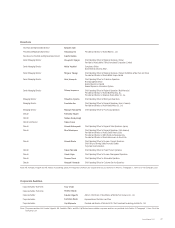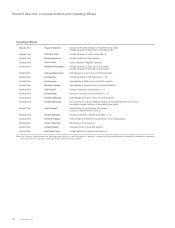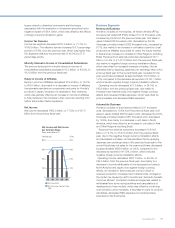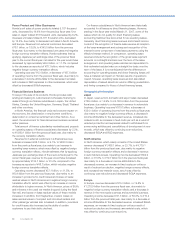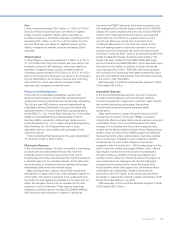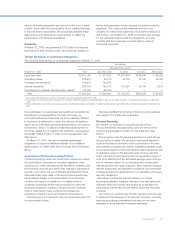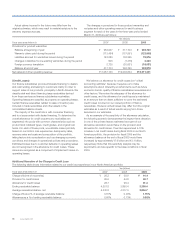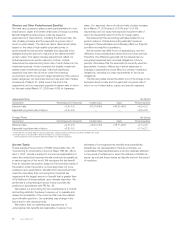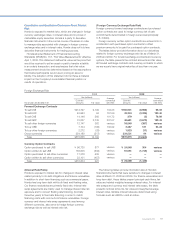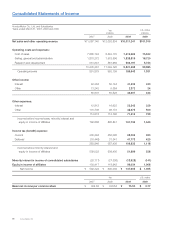Honda 2009 Annual Report Download - page 59
Download and view the complete annual report
Please find page 59 of the 2009 Honda annual report below. You can navigate through the pages in the report by either clicking on the pages listed below, or by using the keyword search tool below to find specific information within the annual report.
rates in estimating expected cash fl ows from the trust or bank
conduit, which affect the recoverability of our retained interests
in the sold fi nance receivables. We periodically evaluate these
assumptions and adjust them, if appropriate, to refl ect the
performance of the fi nance receivables.
Guarantee
At March 31, 2009, we guaranteed ¥33.6 billion of employee
bank loans for their housing costs. If an employee defaults on
his/her loan payments, we are required to perform under the
guarantee. The undiscounted maximum amount of our
obligation to make future payments in the event of defaults is
¥33.6 billion. As of March 31, 2009, no amount was accrued
for any estimated losses under the obligations, as it was
probable that the employees would be able to make all
scheduled payments.
Tabular Disclosure of Contractual Obligations
The following table shows our contractual obligations at March 31, 2009:
Yen (millions)
Payments due by period
At March 31, 2009 Total Less than 1 year 1-3 years 3-5 years After 5 years
Long-term debt ¥2,910,160 ¥ 977,523 ¥1,037,624 ¥798,944 ¥ 96,069
Operating leases 128,673 26,776 34,700 19,142 48,055
Purchase commitments*1144,874 144,874 — — —
Interest payments*2326,718 159,012 120,991 44,140 2,575
Contributions to defi ned benefi t pension plans*382,795 82,795 — — —
Total ¥3,593,220 ¥1,390,980 ¥1,193,315 ¥862,226 ¥146,699
*1 Honda had commitments for purchases of property, plant and equipment at March 31, 2009.
*2 To estimate the schedule of interest payments, the company utilized the balances and average interest rates of borrowings and debts and derivative instruments as of March 31,
2009.
*3 Since contributions beyond the next fi scal year are not currently determinable, contributions to defi ned benefi t pension plans refl ect only contributions expected for the next fi scal
year.
If our estimates of unrecognized tax benefi ts and potential tax
benefi ts are not representative of actual outcomes, our
consolidated fi nancial statements could be materially affected
in the period of settlement or when the statutes of limitations
expire, as we treat these events as discrete items in the period
of resolution. Since it is diffi cult to estimate actual payment in
the future related to our uncertain tax positions, unrecognized
tax benefi t totaled ¥125,771 million is not represented in the
table above.
At March 31, 2009, we had no material capital lease
obligations or long-term liabilities refl ected on our balance
sheet under U.S. GAAP other than those set forth in the table
above.
Application of Critical Accounting Policies
Critical accounting policies are those which require us to apply
the most diffi cult, subjective or complex judgments, often
requiring us to make estimates about the effect of matters that
are inherently uncertain and which may change in subsequent
periods, or for which the use of different estimates that could
have reasonably been used in the current period would have
had a material impact on the presentation of our fi nancial
condition and results of operations. A sustained loss of
consumer confi dence which may be caused by continued
economic slowdown, recession, rising fuel prices, fi nancial
crisis or other factors have combined to increase the
uncertainty inherent in such estimates and assumptions.
The following is not intended to be a comprehensive list of all
our accounting policies.
We have identifi ed the following critical accounting policies
with respect to our fi nancial presentation.
(Product Warranty)
We warrant our products for specifi c periods of time.
Product warranties vary depending upon the nature of the
product, the geographic location of their sales and other
factors.
We recognize costs for general warranties on products we
sell and product recalls. We provide for estimated warranty
costs at the time products are sold to customers or the time
new warranty programs are initiated. Estimated warranty costs
are provided based on historical warranty claim experience with
consideration given to the expected level of future warranty
costs, including current sales trends, the expected number of
units to be affected and the estimated average repair cost per
unit for warranty claims. Our products contain certain parts
manufactured by third party suppliers. Since suppliers typically
warrant these parts, the expected receivables from warranties
of these suppliers are deducted from our estimates of accrued
warranty obligations.
We believe our accrued warranty liability is a “critical
accounting estimate” because changes in the calculation can
materially affect net income, and require us to estimate the
frequency and amounts of future claims, which are inherently
uncertain.
Our policy is to continuously monitor warranty cost accruals
to determine the adequacy of the accrual. Therefore, warranty
expense accruals are maintained at an amount we deem
adequate to cover estimated warranty expenses.
Annual Report 2009 57


